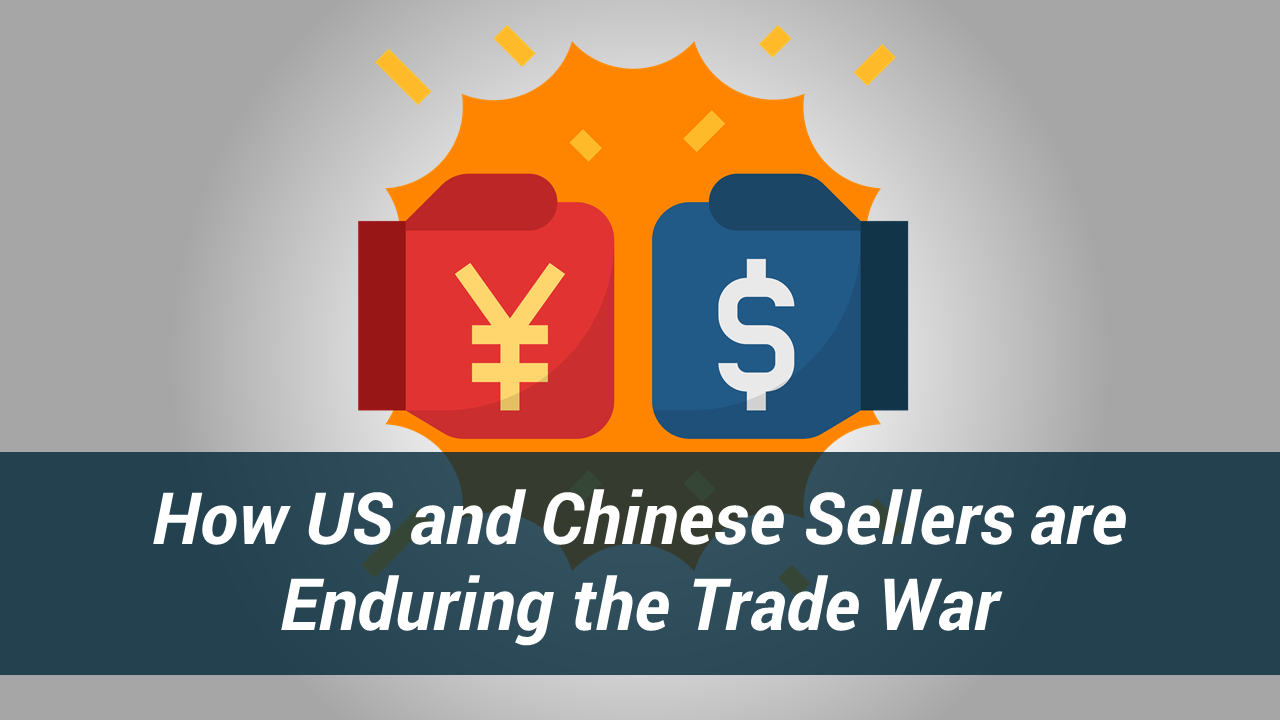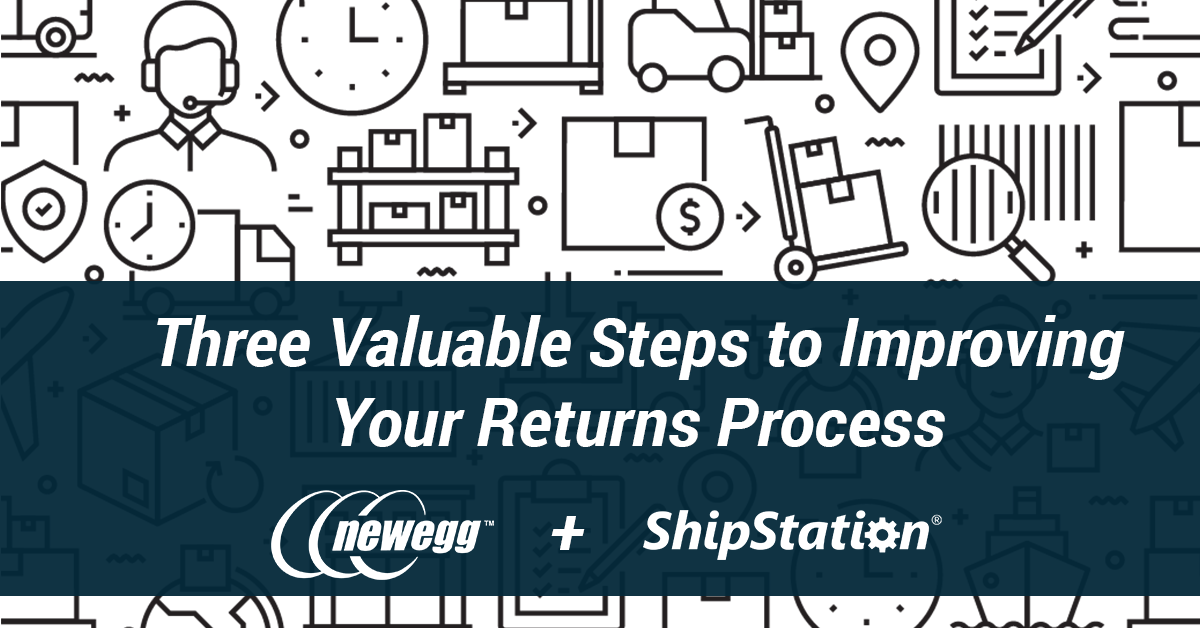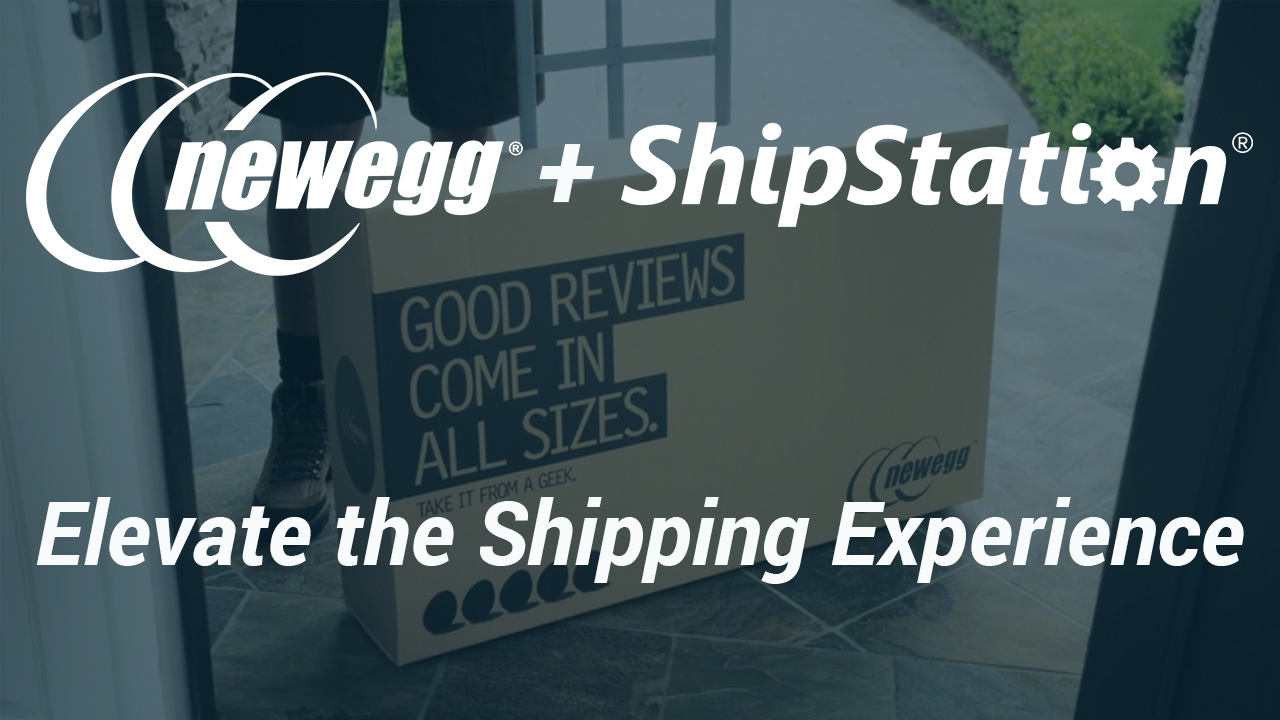




Attracting and retaining customers can be costly and time-consuming. There are many ways you can elevate your brand’s image—keyword analysis, social media, redesigning your website, or even overhauling the U/X. However, there’s one area of focus that increases cart conversions and creates repeat customers: Shipping Experience. Read More

Looking for some guidance as you prepare for the peak holiday season?
Here’s a tip: Think beyond Black Friday.
With the explosive potential of each day from Thanksgiving through Cyber Monday, Black Friday is far from the only shopping holiday online sellers should prepare for.
This was one of several key takeaways from our recent webinar: Discover E-Commerce’s Best-Kept Secrets for Q4. The popular event combined knowledge from e-commerce and logistics experts at Newegg, ShipStation, and ChannelAdvisor to surface the best strategies for holiday selling in 2019.
In case you missed it, here are the highlights.

Looking for some guidance as you prepare for the peak holiday season?
Here’s a tip: Think beyond Black Friday.
With the explosive potential of each day from Thanksgiving through Cyber Monday, Black Friday is far from the only shopping holiday online sellers should prepare for.
This was one of several key takeaways from our recent webinar: Discover E-Commerce’s Best-Kept Secrets for Q4. The popular event combined knowledge from e-commerce and logistics experts at Newegg, ShipStation, and ChannelAdvisor to surface the best strategies for holiday selling in 2019.
In case you missed it, here are the highlights.

Did you know the 2019 holiday season is six days shorter than it was in 2018?
After experiencing one of the longest Thanksgiving-to-Christmas e-commerce seasons last year, sellers are now faced with the shortest on record. Turkey Day falls on November 28, taking the Cyber 5 for a ride into December. This shift has numerous implications that you’ll need to be prepared for.
First, be sure to budget accordingly. While year-over-year revenue may not be as strong in November, there’s a chance you’ll see it rise the following month.
In addition, ensure you have processes in place to handle larger order volumes later in the season. The shorter season means you’ll have less time to handle an increased number of orders, so preparing inventory and logistics is essential.
By the time Halloween costumes are put away on November 1, holiday promotions will already be in full force. That means you’ll need to be ready with advertising extra early this year — and have promotions in place well before Black Friday hits.
Why? Because if you aren’t ready to start encouraging online sales before November 28, you’ll be missing out on a mountain of revenue potential.
Although Cyber Monday is still the biggest online shopping holiday, consumers are starting earlier and earlier. Thanksgiving Day shopping grew 28% year-over-year in 2018 — the biggest increase ever — and experts expect that Thursday-to-Wednesday momentum will continue in 2019.
In fact, based on analysis of sellers using the ChannelAdvisor platform, the strongest year-over-year increase in sales last year occurred on Thanksgiving Eve. With this in mind, be sure your systems are prepared for an influx of traffic starting Wednesday afternoon.

Planning for peak season advertising can be so intensive that it’s easy to let product content fall by the wayside. And yet, that’s exactly what consumers are most interested in. Seven in ten shoppers want to learn about products via content instead of ads.
Set aside time to optimize your listings and personalize your campaigns. In addition to product titles, descriptions and bullets, be sure to prioritize your email campaigns since this is where most consumers get the information they need to make purchasing decisions.
When it comes to price-based promotions during the peak season, timing is everything. Our e-commerce experts suggest focusing on increased traffic starting November 1, followed by price drops as you get closer to Black Friday.
You can also maximize your profits by adjusting pricing intelligently. The last thing you want to do is drop to your bottom price right out of the gate. Customers will continue to shop throughout the holiday season, so you’ll need to have a bank of offers ready if you want to stay competitive well into December.
For example, minimum order promotions can be a great way to ensure your average order value is preserved as you entice customers to engage with your deals. If you can’t offer a discount — such as “spend $100, get 10% off — consider using a free shipping strategy to incentivize consumers to increase basket size.
If you’re selling on Amazon and eBay, you already have a great start. But based on the latest findings, it’s time to ramp up marketplace expansion.
Half of all worldwide online sales come from marketplaces, which jump during peak season. An impressive 60% of consumers plan to shop on marketplaces during the 2019 peak holiday season.
Yet another reason to expand your marketplace presence: Different marketplaces make it easy to extend different options for shipping and promotions, which allows you to extend a variety of offers to consumers. Consider options that allow you to reach wider audiences, such as Newegg, Walmart and Rakuten.
Just keep in mind that you’ll still want to maintain some individual value on each platform. It wouldn’t make sense to diversify your channels only to offer the same promotional deals on all of them.
The trick is to stagger your offers across various marketplaces to maximize your impact all season long. This “price exclusivity” will help ensure each placement is primed for success in the best way, and also keeps your partners happy.
If you really want to generate as much revenue as possible this season, expanding to global markets is key. More than 80% of retailers worldwide agree that cross-border e-commerce has been profitable, and 70% of consumers purchase from foreign sites.
Global selling can be highly lucrative during peak seasons, to say the least.
Of course, extending your reach across international borders can feel like a logistics nightmare when you’re just getting started.
To avoid issues and keep things running smoothly, the key is to focus on shipping software that can help manage international components such as international labels and customs forms.
This is also a time when you’ll want to overcommunicate delivery times, shipping costs and related information, since these are likely to take longer and cost more for overseas fulfillment.
Looking for more insights you can use to get a bigger competitive advantage in the Q4 holiday season for 2019? We have plenty! Leading experts go into greater detail on each of the above trends and strategies in our recent webinar. Watch it on-demand now for practical suggestions from ChannelAdvisor, ShipStation and Newegg.
This post was contributed by Cindy Puryear, Partner Marketing Manager for ChannelAdvisor.

Each year, more customers pivot from brick and mortar stores to online shopping. As this overall volume increases, it’s only logical that holiday sales would also trend upwards. In fact, 2018 Black Friday brought in $6.2 billion in online sales, a growth of 23.6% year over year. Naturally, with increased online holiday shopping there is an increase in holiday shipping. And while there are more opportunities to attract more customers, this also makes for that much more competition. Understanding changing consumer demand is what makes you stand out among the competition and is your best shot at winning more sales and gaining repeat customers once the holiday season ends.
While consumer demand for express shipping is high, there is still a greater emphasis on free shipping among most customers. According to the National Retail Federation, 75% of consumers expect free shipping on orders over $50. This is up from 68% in 2017.
To break it down into generations, Baby Boomers (born 1946-1964) wanted free shipping more than other groups—88% actually expecting it. That compares with 77% for Generation X (1965-1980), Millennials were the lowest with 61% for Millennials (1981-1994) and 76% for Generation Z (1995 and later).
While cart abandonment is an ever-present issue, many customers won’t even place an item in their cart unless they know shipping will be free. As we move into the holiday season—particularly the big, high-competition shopping days like Black Friday and Cyber Monday—free shipping can mean the difference between making a sale or not. In fact, ShipStation’s survey and found that 69% of consumers would rather have free 5-10 day shipping than pay for it to arrive more quickly.

While Amazon Prime has rewired how we think about online delivery, not everyone sees all online purchases as needing express shipping. Express shipping is still important, but it is still seen as a value-added charge. This is particularly true of items in the following categories:
• Medicine
• Food
• Electronics
• Pet Supplies
• Personal Care & Hygiene Products
Express shipping is generally seen as 2-day delivery and quicker. ShipStation’s study found that only 49% of consumers expect it to be offered. And 37% expect to have to pay for this option.
The major reason to offer expedited shipping, though, is that it is often incorporated into gift buying. In ShipStation’s study, 76% percent of customers said they are more willing to pay for expedited shipping if it is as a gift for someone else. As we approach the holiday season, especially December’s procrastinators, offering expedited holiday shipping is a great way to increase cart conversions.
Whether you can offer expedited or free shipping or not is one thing. But, expeditiously shipping products out of the warehouse is a must. The sooner a customer receives their shipping confirmation email with the tracking link, the sooner they breathe a sigh of relief. Staying on top of order fulfillment can be challenging, but it leads to repeat customers. Offering free “Same-Day Shipping” is a great way to incentivize customers to shop with you. This doesn’t mean they’ll receive their order the same day they place it. It just simply means that you’ll ship out an order on the day it’s placed. Using a shipping software is a great way to stay on top of your order volume and keep them going out the door as quickly as they come in.
Returns are objectively unenjoyable for everyone involved—except the carrier. However, there is a lot of selling power in doing returns well. According to Allbusiness, 91 percent of customers factor return policies into their online shopping. During the holiday season, returns are more common. And a website that doesn’t offer returns, or offer them well, will likely be sidelined in favor of a company that has a good returns policy.
80% of customers expect to be able to return purchases for free. This can be difficult to offer—particularly if you offer free outbound shipments as well. This is certainly an area that express shipment is not necessary. If you can use cost-effective shipping options like First Class Mail or hybrid services (Surepost or Smartpost), do it.

As customer demands shift and grow more towards express and free shipping, it’s important to protect your profit margins. While free shipping and easy returns can be costly, remember that these options are the new norm for many customers. And, unfortunately, if you can’t offer these shipping options to the customers, there’s likely someone else who can.
About the Author: ShipStation is the world’s leading web-based shipping solution that helps e-commerce retailers import, organize, and ship orders quickly and easily—wherever they sell, however they ship. ShipStation integrates with over 160 of the top marketplaces, selling channels, carriers, and fulfillment providers. Utilize features like auto-selecting shipping preferences, customizable automation rules, multi-carrier rate calculators and shipping, and much more.

Each year, more customers pivot from brick and mortar stores to online shopping. As this overall volume increases, it’s only logical that holiday sales would also trend upwards. In fact, 2018 Black Friday brought in $6.2 billion in online sales, a growth of 23.6% year over year. Naturally, with increased online holiday shopping there is an increase in holiday shipping. And while there are more opportunities to attract more customers, this also makes for that much more competition. Understanding changing consumer demand is what makes you stand out among the competition and is your best shot at winning more sales and gaining repeat customers once the holiday season ends.

If you’ve been following along with our SEO blog series, you should have a solid understanding of how search engines work, and insight into the history of search engine optimization. Now that you have the context and background behind SEO, let’s take a look at five key principles for getting your listings to the top of Google’s search results, and keeping them there.
In some ways, the old edict of “the customer is always right” can be adapted to SEO. When you’re working on optimizing your content, your guiding principle should be doing what’s best for the searcher. Another way to look at this golden rule of SEO is to think of your customers as being on a quest to find your products, and that everything you do to make your listings easier to find directly helps them along their journey.
Here are a few things to keep in mind when helping your audience reach their destination:
If you’re going to do what’s best for the searcher, you need to think about more than just a single query that you want to rank for. If you’re selling, say, a smart thermostat, it’s not enough to just cover a single search intent — you need to cover ALL people’s search intent.
Think of some other keywords directly or peripherally related to your product. When you’re designing content for that product listing it would be beneficial for both you and your audience to address all these facets of the topic on the page.
By doing so, you’re increasing your page’s relevancy for more than just a single query, and you’re enhancing your customer’s experience by making your listing a sort of one-stop-shop that fulfills every search intent they have. Best of all, you’re broadening your reach by focusing on more than just one potential keyword.
See all the various topics related to the smart thermostat in the image below:

Broad search terms aren’t usually going to lead a purchase. It’s the narrow and highly specific terms where you have an engaged audience who is interested in purchasing a product.
Let’s return once more to the smart thermostat example: if you want searchers to discover your listing, keywords like “thermostat” or “air conditioner,” while important to target, aren’t going to be enough to bring in the customers who would be most interested in purchasing your product.
By targeting more specific terms related to your product, like “Wi-Fi thermostat” or “learning thermostat” in this example, you are laying down a much clearer path for your target audience to reach your listing and buy your product.
If you want to aid Google in getting your product in front of searchers, you need to give it a deep dive into your product’s specifications. The more details you provide, the more opportunity you have to be crawled and ranked.
To elaborate, Google thrives on knowing what people are searching for. Ideally, every product listing you create should have as many of the specs added to the page as possible so that when Google crawls and indexes the page, it has the data it needs to analyze and understand what search queries you should be matched to.
This information can also affect where you’ll show up on that page — if you don’t have as much relevant content as Google feels you need for the topic, they may not rank you as high.
Here are just a few mandatory behaviors when filling out product specs:

Make sure your products are labeled with the proper brand. It sounds obvious, but omitting this piece of essential information is more common than you may think.
It should go without saying, at this point, that leaving out the brand or manufacturer can hurt the product’s visibility in search. If a user doesn’t find this information, they may end up deciding not to purchase.
Missing specs don’t benefit anyone. Again, doing what is best for your customer benefits SEO.
By giving your customer as many details about a product as possible, you’re making their buying experience easy, and in turn, making them more likely to purchase — all while increasing your visibility to search engines. Another tactic to consider when creating content for greater visibility is to include questions for any product questions a customer might ask.
Putting your product in the wrong category can be an easy mistake. If a product is too ambiguous to nail down to one specific category, turn to the SEO principle of thinking about what your audience would search for and categorize accordingly.
Be honest with your specifications. Don’t mislabel a product or place it in a category it isn’t meant for as a way of trying to increase visibility — doing so is playing with fire. Google’s algorithms are sophisticated enough these days that they may weed out pages that are intentionally trying to exploit it, which can have severe repercussions.

What your customer wants and what Google wants is the same: quality content.
Create a robust overview that gives customers a look at your product from every angle. It’s one thing to specify a fast shutter speed on a camera, but it is even better to explain further what circumstances that shutter speed is used for. Having high-quality content helps the search engines understand what your product can do and improve the visibility to your customers.
Here are a few elements that will enhance your product content:
For more help, here are some SEO best practices for ecommerce product pages.
Google is always looking for the best way to improve a user’s experience. That principle should be at the core of your decision-making in SEO. Everything you do in optimizing your listings should be tied back to the fundamental question, “Is this the best experience for my customers?”
It may sound idealistic, but the truth is that if you always work towards doing what’s best for your customers, you’ll find that Google, whether actively or passively, is aiding your business in turn.
SEO takes consistent effort: There’s no magic formula or instant fix when it comes to improving page rankings. It requires frequent attention and an ability to quickly adapt to changes (Google changes their algorithm, on average, every thirteen hours). Making sure you’re always relevant in a changing world is tough, but it will keep you at the forefront of customers’ minds. And that makes SEO one of the best investments a business can make.
While this is the final entry in our SEO blog series, we still have plenty to share when it comes to helping you reach the peak of search results. For more tips on optimizing your listings visit us at newegg.com/sellers, and be sure to check out our SEO eBook!